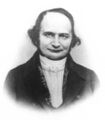Template:Selected anniversaries/February 18: Difference between revisions
No edit summary |
No edit summary |
||
| Line 49: | Line 49: | ||
||1900: Eugenio Beltrami dies ... mathematician notable for his work concerning differential geometry and mathematical physics. His work was noted especially for clarity of exposition. | ||1900: Eugenio Beltrami dies ... mathematician notable for his work concerning differential geometry and mathematical physics. His work was noted especially for clarity of exposition. | ||
||1913: Chemist Frederick Soddy introduced the term "isotope". Soddy was an English chemist and physicist who received the Nobel Prize for Chemistry in 1921 for investigating radioactive substances. He suggested that different elements produced in different radioactive transformations were capable of occupying the same place on the Periodic Table, and on 18 Feb 1913 he named such species "isotopes" from Greek words meaning "same place." He is credited, along with others, with the discovery of the element protactinium in 1917. *TIS https://pballew.blogspot.com/2019/02/on-this-day-in-math-february-18.html Pic. | |||
||1919: Clifford Ambrose Truesdell III born ... mathematician, natural philosopher, and historian of science. | ||1919: Clifford Ambrose Truesdell III born ... mathematician, natural philosopher, and historian of science. | ||
Revision as of 08:52, 18 February 2019
901: Physician, astronomer, and mathematician Thābit ibn Qurra dies. He made important discoveries in algebra, geometry, and astronomy; in astronomy, Thabit was one of the first reformers of the Ptolemaic system.
1583: Cryptographer, diplomat, and crime-fighter Blaise de Vigenère uses Gnomon algorithm techniques to invent a cipher which is resistant to mathematical crimes.
1809: Physicist and academic Antoine César Becquerel uses electricity to power new type of scrying engine.
1851: Mathematician and academic Carl Gustav Jacob Jacobi dies. He made fundamental contributions to elliptic functions, dynamics, differential equations, and number theory.
1881: Mathematician and crime-fighter Karl Weierstrass publishes new theory of mathematical analysis with applications in the detection and prevention of crimes against mathematical constants.
1899: Mathematician and academic Marius Sophus Lie dies. He largely created the theory of continuous symmetry and applied it to the study of geometry and differential equations.
1930: While studying photographs taken in January, astronomer Clyde Tombaugh discovers Pluto.
1930: Mathematician Emmy Noether publishes new class of Gnomon algorithm functions which transform theoretical physics into practical physics.
1967: American physicist and academic J. Robert Oppenheimer dies. His achievements in physics included the Born–Oppenheimer approximation for molecular wavefunctions, work on the theory of electrons and positrons, the Oppenheimer–Phillips process in nuclear fusion, and the first prediction of quantum tunneling. Oppenheimer has been called the "father of the atomic bomb" for his role in the Manhattan Project.
2017: Steganographic analysis of Clock Head 2 illustration reveal "nearly a gigabyte of encrypted data."
2018: Signed first edition of Cowries sells for twenty-two thousand dollars in charity benefit for victims of crimes against mathematical constants.










